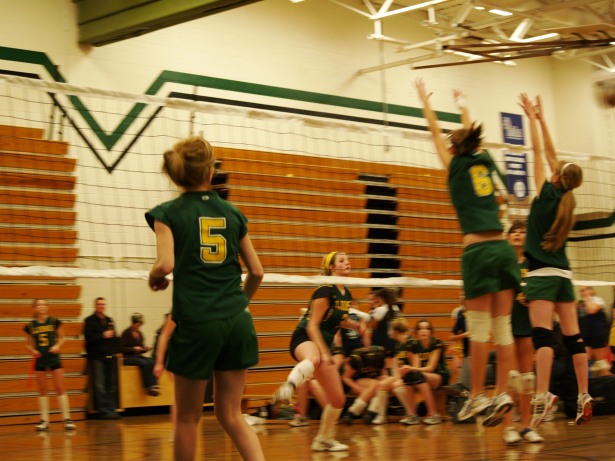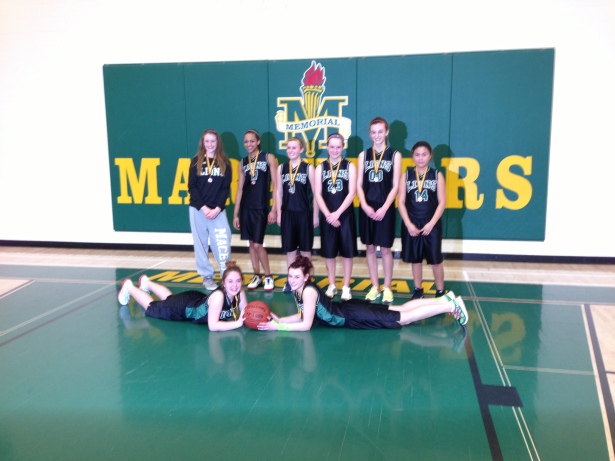I have written a number of posts on this blog about my role as a coach and athletic rep at my school. The most recent one about the struggle to find coaches and ensure that students who want to play at least get the chance to tryout. Last week I read an article by Dr. Doug Gleddie expressing his disappointment with school sports. He lists 3 things in particular that are causing his negative outlook despite many years as both a player and coach of school sports. They were: 1. Participation Rates 2. Elitism and 3. Winning First.
The article made me stop and think about school sports and their impact on me as a young player and as a coach and athletic administrator. There are, most certainly, some frustrations, but as I reflected, it was evident that the positives and long term benefits of school sports largely outweigh those frustrations.
Dr. Gleddie states that in his experience only around %25 of students actually play school sports. While I haven’t crunched the numbers at my school to compare, the one thing I do know is that school sports are competing heavily with outside sports and leagues. Each year at my school (k-9 approx. 480 students – 240 in 7-9) we have a good number of kids who are interested but chose not to play school sports because of their commitment to equestrian, football (not a school sport in Jr. high), soccer, community basketball, dance, cheer, swimming, hockey as well as others. Opportunities are out there for young people to find their passions athletically. School sport is no longer the be-all and end-all for competitive athletics. I believe that the percentage of kids who are gaining the benefits of physical activity, socialization and competitive challenge from sport are much higher that Gleddie’s %25. Also, school sport is optional…we don’t HAVE to be offering any sports. Even if participation is “only” %25, that is a large number of kids who are getting an opportunity they wouldn’t have otherwise.
Not all kids are interested or passionate about sports or competition. Extracurricular sports teams are not meant to reach every student. If you look at schools across Alberta and Canada, you will find extracurricular programs in a large number of disciplines. All of these programs are meant to feed the emotional and physical needs of our youngsters. Assuming that all (or even most) students would like to be on a sports team is quite presumptuous.
Yes, I have seen elitism in sports. I have seen it in drama and music programs as well. The onus has to be on coaches to make sure they are doing their best to develop a whole team of athletes. Teaching a young player and their teammates what it means to “play a role” is a vital lesson that can be used in many areas of life. In our junior high athletic program, we believe strongly that all kids need to play significant amounts of time in order to learn and improve the needed skills. However, there are other things that come in to play when a coach doles out minutes on the court or field. Does the athlete miss practices? Do they work their hardest at drills during practice time? What about character? Do they treat their coaches and teammates with respect? The officials?
I truly believe that a “winning first” attitude of coaches or athletic programs is a thing of the past. I have seen very, very few examples of this kind of focus in 15 years of coaching at the Jr. High level. Generally, coaches are looking to teach the sport and social skills and attitudes that will help athletes in all areas of their life. Teaching them HOW to learn is as important as teaching them how to dribble a soccer ball, throw a football or shoot a hockey puck. In Canada, school coaches are not paid at all for their time. That alone shows that winning is not the top priority in our school athletic programs. Providing opportunities for our student/athletes is. In the athletic association of which I am a part, we have even put in rule changes in both our volleyball and basketball leagues to support player skill development and move away from placing importance on winning.
Are school sports perfect? Nope.
Are there some examples that illustrate Dr. Gleddie’s three issues with school sports? Yup.
Could we make some changes to how school sports are run/organized/coached? Probably.
Are there undeniable benefits to participation in school sports? Most certainly.
Another interesting point about Dr. Gleddie’s post is that he states himself that, “To be honest, I am not really sure what we should do.” I’m never a fan of making a complaint without having input as to what could be done instead, or done to improve whatever it is we are complaining about.
Even though I am not complaining about school sports, I do have one suggestion for Dr. Gleddie, schools, coaches and athletic organizations, that may help with improving some of the areas he is disenchanted with. I think that it is vitally important to decide as an organization what you believe and value and to make a public statement to shareholders as to what those team/organization cornerstones are. The next step is to ensure that decisions and actions express that same worldview. Follow up. “Put your money where your mouth is” so to speak.
I’d love to hear your opinions on school sports and on what is working and what isn’t. What do you think needs to change (if anything) about coaching and sport administration in your area?




Great read Marci! I felt the same way as you when I read the Doug Gleddie article. Thanks for taking the time to put your opinion out there for others to see and think about:)
Good Morning,
There are a couple of quick comments I’d like to make. I read Doug’s post as well and wrote my own blog response last night.
The first is your comment, “Not all kids are interested or passionate about sports or competition. Extracurricular sports teams are not meant to reach every student. If you look at schools across Alberta and Canada, you will find extracurricular programs in a large number of disciplines. All of these programs are meant to feed the emotional and physical needs of our youngsters. Assuming that all (or even most) students would like to be on a sports team is quite presumptuous.”
You will find no disagreement from me here. We often say the same thing here in the States. I find it highly interesting despite this being our view of the purpose of extracurricular activities (including sports), why do our actions still speak so loudly in contradiction to this? At our school, we still release students for sports several hours early so they can travel long distances to compete, we hang banners in our school to celebrate undefeated seasons, We organize assemblies that always involve participation from the athletes who are in the very small minority of our student population. Why this glorification of “school sport?”
As for the “winning first” attitude I interpret that more as figurative as opposed to literal. I hear it ad nauseam from coaches/parents/administrators that at youth sports it is about skill development and not winning. We certainly talk the talk. I don’t think we walk the walk. I define the “winning” mentality in school sport that I see as the a race to keep up with the Joneses. To win the battle at getting noticed. To win the college scholarship that many think is so attainable.
I see huge inequities in playing time with middle school sports. The most polished players still play the most. While the players who are new to the game, receive far less. I’ve heard every excuse in the book from, “it isn’t fair to anyone on the team to give some of those kids extensive playing time” to, “I am afraid that the player would get hurt” to, “Their learning comes at practice, they just aren’t ready for serious game time.” None of those excuses do anything for me than to feed the mentality that it is about “winning” even if that doesn’t involve a scoreboard.
Adam, thank you so much for your comment. At our school just this week we have had a small amount of conflict over the idea of releasing athletes early to play in games during school hours. Our principal is against this and that sparked a debate over the validity and purpose of having athletes (and teacher/coaches) miss school for sports. I hadn’t really considered this as an example of elitism, but I see know that it could definitely been seen that way. I do know that at our school, we release drama students for a week at a time to prepare and perform their theatre production. For us, that is the only somewhat parallel example.
There is no doubt that in our area you could find a ton of different philosophies of playing time depending on the coach, the school, the league, the tournament. My own philosophy has changed and evolved over the years. Even last night, our grade 8/9 boys basketball team played against a stronger team in a tournament. The other team had 12-15 players on it, yet 5 of them played the vast majority of the game even though they were up by approximately 20 points most of the game.
I do think that it comes down to teams, schools, and athletic organizations stating clearly what their goals and philosophies are to all stakeholders (players, coaches, parents, officials, etc.) and then making sure that actions, rules and decisions are in place to meet those goals and philosophies. You’re right, I’ve never been to a pep rally for the music students or the art walk!
Thanks again for taking the time to express your thoughts.
Thanks for the thoughtful reply, Marci.
Yes, I have seen this and it breaks my heart. Games that have a 20 point swing one way or another–and you see the same 5-6 players out on the court the entire time. The way our “middle school sports” are structurd they create a “varsity” and “junior varsity” schedule. The more I see this model in practice the more I disagree. Usually the varsity gets 15-20 games in a season and the junior varsity gets 7-8. Our varsity team this year wasn’t competitive, and didn’t win a game. However, even in games when they were down by 15-20 points, the same 5-6 “varsity” players played the whole game, while the “JV” players were expected to sit on the bench and cheer on their teammates.
I just don’t get that philosophy and I would like to see it change.